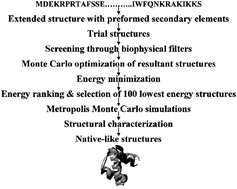A computational pathway for bracketing native-like structures for small alpha helical globular proteins†
Abstract
Impressive advances in the applications of bioinformatics for protein structure prediction coupled with growing structural databases on one hand and the insurmountable time-scale problem with ab initio computational methods on the other continue to raise doubts whether a computational solution to the


 Please wait while we load your content...
Please wait while we load your content...